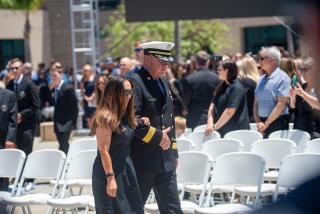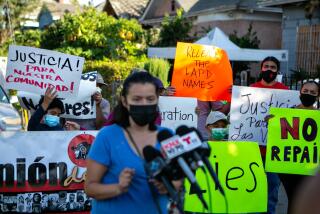‘Twilight’ Technician Says Safety Duty Was His
- Share via
The technician whose special-effects explosions caused a fatal helicopter crash during the filming of “Twilight Zone: The Movie” testified Tuesday that safety was his ultimate responsibility--not that of director John Landis.
“The final decision is yours, is that correct?” defense attorney Arnold Klein asked special-effects technician James Camomile in cross-examination in Los Angeles Superior Court.
“Essentially, yes,” replied Camomile, a witness who has been granted immunity from prosecution at the involuntary manslaughter trial of Landis and four associates.
“It was your responsibility . . . to make sure that everything was safe, is that correct?” asked Klein, who represents special-effects coordinator Paul Stewart.
“Yes, sir,” Camomile replied.
“You were the one who had the final duty to abort the firing if you felt it wasn’t safe, isn’t that correct?” the attorney said.
“That’s correct,” Camomile said.
“And if you thought it wasn’t safe, you would have stopped the firing, isn’t that correct?” Klein asked.
“Yes, sir,” Camomile responded.
Powerful special-effects explosions set off by Camomile during the “Twilight Zone” filming crippled the rear rotary blade of a helicopter being used in a Vietnam War scene, causing it to crash down on actor Vic Morrow and two child actors, killing them.
The crash, which the defense contends was unforeseeable, occurred July 23, 1982, in rural northern Los Angeles County.
Landis, Stewart and three associates were later indicted on involuntary manslaughter charges in the three deaths. Camomile was granted immunity from prosecution by the district attorney’s office in exchange for his testimony.
Defense attorneys have labeled Camomile the “triggerman” and say it was his responsibility to make sure the aircraft was safely away from his position before he set off the blasts.
But Deputy Dist. Atty. Lea Purwin D’Agostino maintains that Landis had the ultimate authority on the set and that mortars containing the special-effects bombs that downed the helicopter were placed in position with the director’s approval.
The prosecutor contends that Camomile would not have set off the explosions had Landis told him the helicopter would be flying much lower--and therefore closer to the blasts--than it had in a previous scene.
In other testimony, Camomile conceded under cross-examination by Landis’ attorney, former special Watergate prosecutor James Neal, that he did not hear “every detail” of a purported key conversation between Landis and special-effects coordinator Stewart.
On Monday, Camomile testified that about 90 minutes before the helicopter crash, he overheard Landis tell Stewart that he wanted a mock Vietnamese hut blown apart by special-effects explosions.
D’Agostino contends that Landis and Stewart were reckless because they knew debris from the hut could cause the helicopter to crash.
On Tuesday, Camomile testified that he “did not hear every detail of their conversation.”
The defense maintains that the crash occurred when intense heat from the explosions melted the helicopter’s rear rotary blade, and contends that it was the first time in aviation history that a helicopter crashed due to “heat delamination.”
More to Read
Sign up for Essential California
The most important California stories and recommendations in your inbox every morning.
You may occasionally receive promotional content from the Los Angeles Times.













